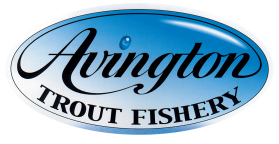Let’s start by taking a look at the fishery itself. The water is clear, and deep in places. So the trout take advantage of the natural cover.
LAKE 1
It is long and narrow with the best stalking vision obtained from the right-hand side. This is due to the high screen of trees on the opposite bank throwing a shadow on the surface. With minimal surface glare this bank is ideal for spotting fish, although you should watch your back cast for snags. The bottom end of the first lake, or at least the lower third, can be excellent.
LAKE 2
The largest of the lakes with the shallow side joining the fields, and the riverside bank holding most of the fish. There is one exception and that is the inflow to this lake. Here a large tree overhangs what was used to be called the Inlet. Twenty years ago it was where many of the “names” would fish, targeting the trout twice — first as they cruised in; then again as they cruised out. At the bottom of the middle lake on the right is an overhanging tree. This is a great spot to “jungle” fish, using the catapult cast to flick the fly under the tree. Most anglers walk right past it. At the bottom end of the right bank is a bed of rushes. By all means look into the usual worn swims, but don’t be afraid to part the rushes with your rod to see what is there. Many trout lie stationary between two used swims, unseen by anglers on either side.
LAKE 3
This lake is very deep and always holds trout. The sun travels in its westward arc along the left-hand field bank, so the light over your shoulder gives you some good spotting areas. The lower end used to be excellent, but the saplings of 20 years ago are now fully-grown trees making for the sort of conditions where the catapult cast reigns supreme. Close-combat techniques in all these areas will definitely bring you fish.
